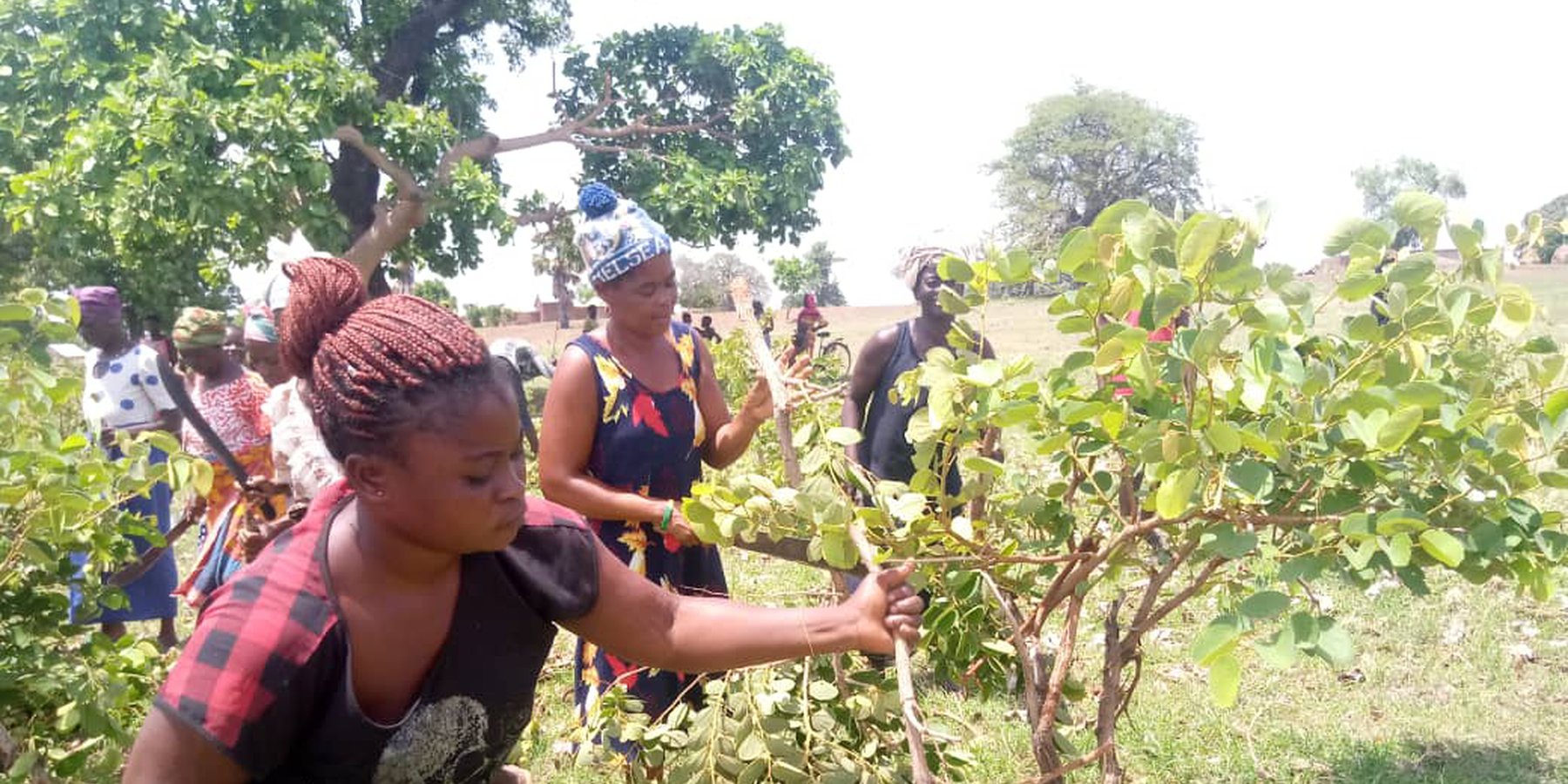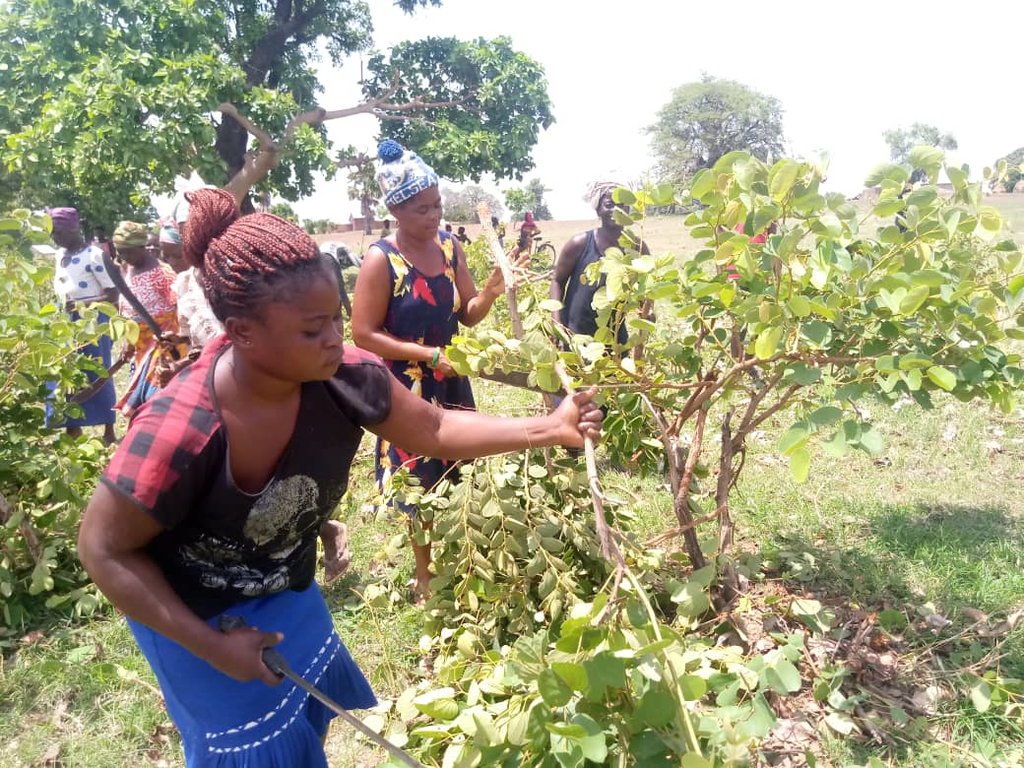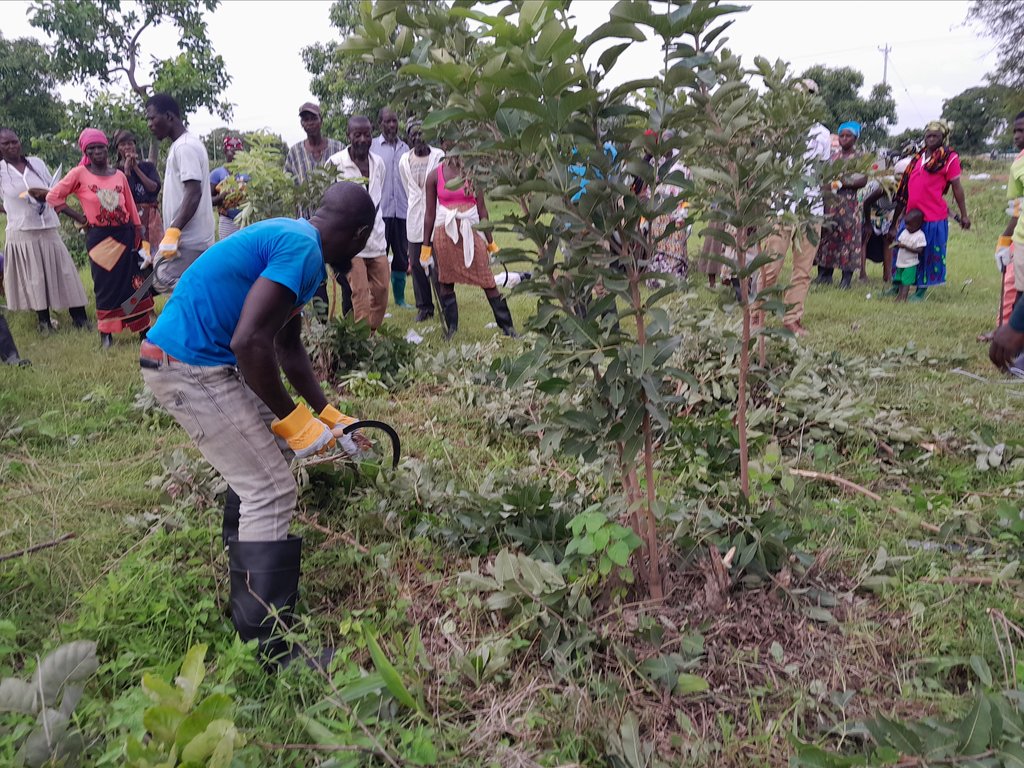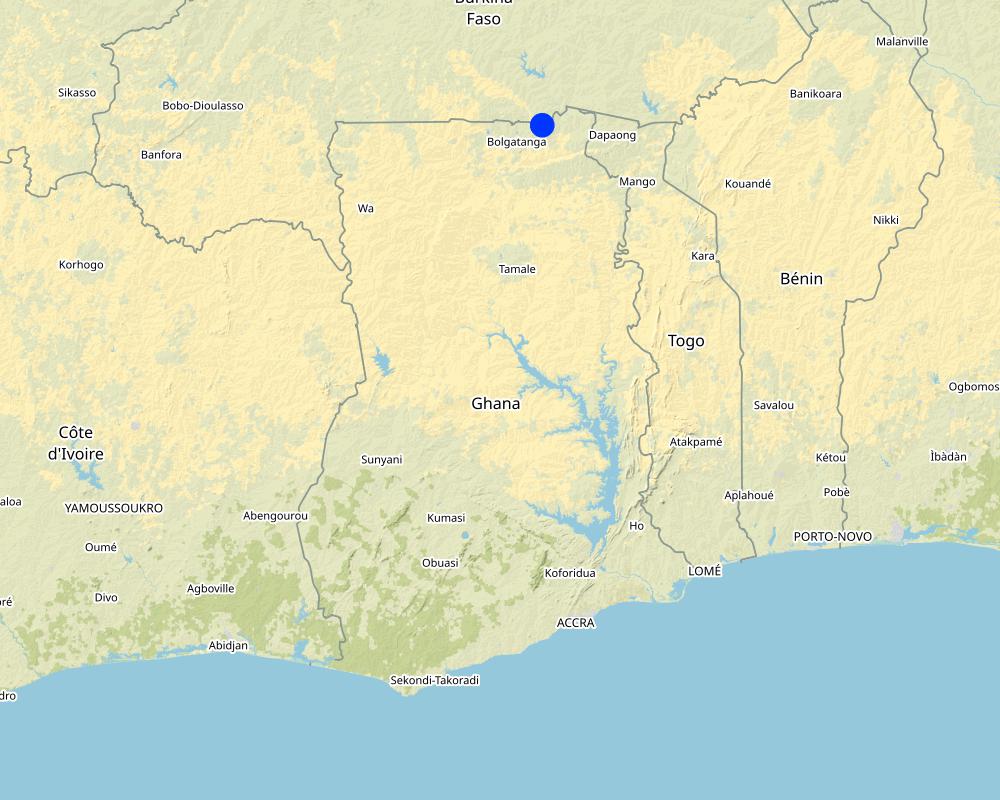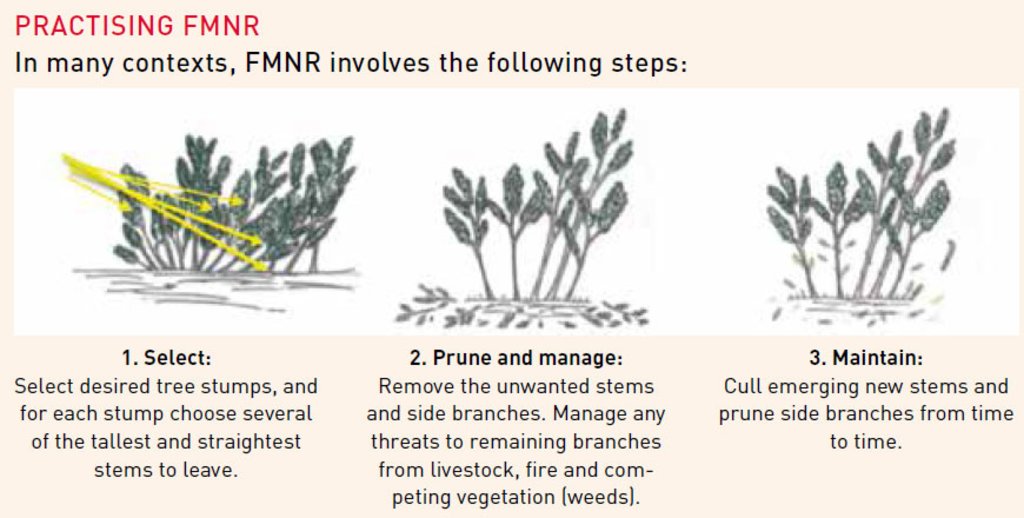Farmer Managed Natural Regeneration(FMNR) [加纳]
- 创建:
- 更新:
- 编制者: Joshua Adombire
- 编辑者: –
- 审查者: William Critchley, Rima Mekdaschi Studer
Tintuug lebge tii
technologies_6599 - 加纳
查看章节
全部展开 全部收起1. 一般信息
1.2 参与该技术评估和文件编制的资源人员和机构的联系方式
关键资源人
World Vision Regreening africa Project staff:
Adombire Joshua
World Vision
加纳
有助于对技术进行记录/评估的项目名称(如相关)
Reversing land degradation in Africa by scaling-up Evergreen Agriculture (Regreening Africa)有助于对技术进行记录/评估的机构名称(如相关)
Not applicable (Not applicable) - 美国1.3 关于使用通过WOCAT记录的数据的条件
编制者和关键资源人员接受有关使用通过WOCAT记录数据的条件。:
是
1.4 所述技术的可持续性声明
这里所描述的技术在土地退化方面是否存在问题,导致无法被认为是一种可持续的土地管理技术?:
否
注释:
The technology has empirically proven to have no adverse effects on land and any other agrarian venture
1.5 参考关于SLM方法(使用WOCAT记录的SLM方法)的调查问卷
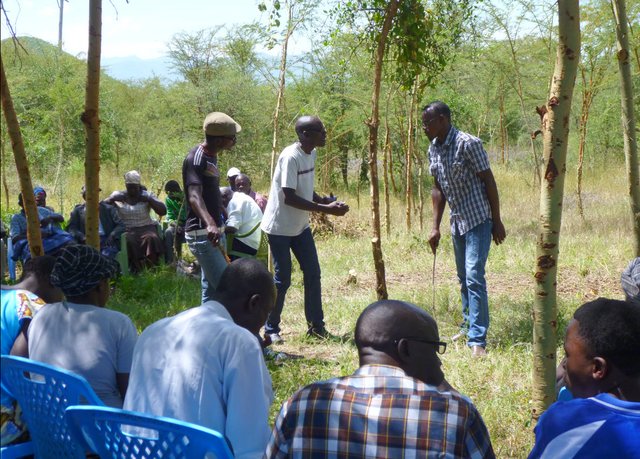
FMNR implementation approach [肯尼亚]
After consultations with local stakeholders, experts (from NEMA, ICRAF, KFS, Wildlife Kenya) and Homabay County Government representatives the FMNR approach is being introduced by World Vision through a public funded project. The aim of the approach is to promote FMNR and sustainable land and natural resource management through disseminating the …
- 编制者: Thomas Kalytta
2. SLM技术的说明
2.1 技术简介
技术定义:
Farmer Managed Natural Regeneration (FMNR) comprises a set of practices used by farmers to encourage the growth of native trees on agricultural land by systematically allowing regeneration and managing trees and shrubs from tree stumps, roots and seeds.
2.2 技术的详细说明
说明:
Farmer managed natural regeneration (FMNR) is an agroforestry practice that involves the deliberate protection and management of naturally regenerating woody vegetation by farmers on agricultural land. On farmland, selected trees are trimmed and pruned to manage their growth while promoting optimal growing conditions for annual crops (such as access to water and sunlight). Naturally it is a prerequisite that there should be evidence of sprouts from stumps or roots. FMNR is practiced through - but not limited to - the following:
1. Survey of the farm noting how many and what species of trees are present; In our project impact communities, the commonest indigenous tree species are Vitellaria paradoxa, Parkia biglobosa, Adansonia digitata, Piliostigma thonningii, Combretum spp, Diospyros mespiliformis, Lanea macrocarpa, Faidherbia albida, Acacia spp etc
2. Select the stumps of the desired species for regeneration; and
3. Select the best five or so stems and cull unwanted ones.
FMNR can restore degraded farmlands, pastures and forests by increasing the quantity and quality of woody vegetation, by increasing biodiversity and by improving soil structure and fertility through leaf litter and nutrient cycling. It has been reported in Senegal and Ghana in 2011 and 2012 that households practicing FMNR were less vulnerable to extreme weather shocks such as drought and damaging rain and windstorm. Conventional approaches to reversing desertification, such as tree planting, rarely spread beyond the project boundary once external funding is withdrawn. By comparison, FMNR is cheap, rapid, locally led and implemented. It uses local skills and resources – the poorest farmers can learn by observation and teach their neighbors. This technique is popular with land users because it is a low-cost and rapid sustainable land restoration technique. A well-established FMNR is succeeded by Farmer Managed Agroforestry (FMA) where farmers are cultivating annual crops as well are conserving indigenous tree species on the arable lands. Farmers go step ahead to do enrichment planting of preferred trees species such as Mangifera indica, Anacardium occidentale, Luceaena leucocephala etc.
2.3 技术照片
关于照片的一般说明:
Farmers are always excited to learn the technique since it is easy to do irrespective of the physique of the person.
2.4 技术视频
注释、简短说明:
https://1drv.ms/v/s!AszYv0MhwVNji1-Kuo6kZRifcMzj?e=CMPcE0
日期:
17/12/2022
位置:
Bawku West district
摄影师的名字:
Joshua Adombire
2.5 已应用该技术的、本评估所涵盖的国家/地区/地点
国家:
加纳
区域/州/省:
Upper East
有关地点的进一步说明:
Widnaba Community in Bawku West district
具体说明该技术的分布:
- 适用于特定场所/集中在较小区域
技术现场是否位于永久保护区?:
否
Map
×2.6 实施日期
注明实施年份:
2017
如果不知道确切的年份,请说明大概的日期:
- 不到10年前(最近)
2.7 技术介绍
详细说明该技术是如何引入的:
- 通过土地使用者的创新
- 通过项目/外部干预
注释(项目类型等):
World Vision Regreening Africa Project
3. SLM技术的分类
3.1 该技术的主要目的
- 改良生产
- 减少、预防、恢复土地退化
- 保护生态系统
- 保持/提高生物多样性
- 创造有益的社会影响
3.2 应用该技术的当前土地利用类型
同一土地单元内混合使用的土地::
是
具体说明混合土地使用(作物/放牧/树木):
- 农林业

农田
- 一年一作
- 多年一作(非木材)
- 乔木与灌木的种植
年作 - 具体指明作物:
- 谷物类 - 玉米
- 谷类 - 小米
- 谷类 - 水稻(旱地)
- 豆科牧草和豆类 - 豆子
年作制度:
玉米/高粱/谷子与豆类间作
乔木和灌木种植 - 指定作物:
- 腰果
每年的生长季节数:
- 1
采用间作制度了吗?:
是
如果是,说明哪些作物是间作的:
Cashew -legumes, cashew- cereals, Teak- cereals, Mango- cereals etc
采用轮作制度了吗?:
是
如果是,请具体说明:
Cereals and legumes,

牧场
粗放式放牧:
- 半游牧畜牧业
- Free range grazing
动物类型:
- cattle - dairy and beef (e.g. zebu)
- 山羊
- 绵羊
- Donkey
是否实行作物与牲畜的综合管理?:
是
如果是,请具体说明:
Farm residues are feed to animals and the dropping are used as manure for soil improvement. The animals are also used for farm work and other domestic works such as fetching water as in the case of donkeys
产品和服务:
- manure as fertilizer/ energy production
品种:
cattle - dairy and beef (e.g. zebu)

森林/林地
- 植树造林
- Community forests
植树造林:说明树种的起源和组成:
- 混交品种
植树造林类型:
- 热带干林人工林
树木类型:
- 金合欢树种
- 埃及橡形木属
- 柚木属物种
以上的树木是落叶树还是常绿树?:
- 落叶植物
产品和服务:
- 木材
- 薪材
- 水果和坚果
- 放牧/啃牧
- 自然灾害防护
- Medicinal
注释:
N/A
3.3 由于技术的实施,土地使用是否发生了变化?
由于技术的实施,土地使用是否发生了变化?:
- 否(继续问题3.4)
3.4 供水
该技术所应用土地的供水:
- 雨养
注释:
Some farmers dig out wells for vegetable farming in some communities
3.5 该技术所属的SLM组
- 天然和半天然森林管理
- 森林种植管理
- 农业林学
3.6 包含该技术的可持续土地管理措施

农艺措施
- A1:植被和土壤覆盖层
- A2:有机质/土壤肥力
- A3:土壤表面处理
A3:区分耕作制度:
A 3.2: Reduced tillage (> 30% soil cover)

植物措施
- V2:草和多年生草本植物

结构措施
- S1:阶地
- S6:墙、障碍物、栅栏、围墙

管理措施
- M4:活动时间安排的重大变化
- M5:物种组成的控制/变化

其它措施
具体说明:
Mulching
3.7 该技术强调的主要土地退化类型

土壤水蚀
- Wt:表土流失/地表侵蚀

土壤风蚀
- Et:表土流失

化学性土壤退化
- Cn:肥力下降和有机质含量下降(非侵蚀所致)

物理性土壤退化
- Pc:压实

生物性退化
- Bc:植被覆盖的减少
- Bh:栖息地丧失
- Bl:土壤寿命损失
- Bp:害虫/疾病增加,捕食者减少

水质恶化
- Ha:干旱化
- Hs:地表水良变化

其它
具体说明:
Acidification of water bodies
3.8 防止、减少或恢复土地退化
具体数量名该技术与土地退化有关的目标:
- 防止土地退化
- 修复/恢复严重退化的土地
4. 技术规范、实施活动、投入和成本
4.1 该技术的技术图纸
技术规范(与技术图纸相关):
Where there are so many stands, depending on the species, some are culled leaving two to five stands of shrubs or stands. For edible fruit trees, it is recommended a single stem is left to facilitate quicker growth and fruiting.
When pruning, the cutting tool must be very sharp and cutting down upwards but not downwards to prevent tearing of the bark.
Stems must not be prune of side twigs to the apex but halfway up is recommended to give the plant more stability and opportunity for adequate photosynthesis
作者:
Van Schoubroeck, Frank (2018). Integrating trees in farming systems in Baringo County, Kenya reduced variability of food and fodder production.
日期:
17/12/2022
4.2 有关投入和成本计算的一般信息
具体说明成本和投入是如何计算的:
- 每个技术区域
注明尺寸和面积单位:
10 acres
如果使用本地面积单位,注明转换系数为1公顷(例如1公顷=2.47英亩):1公顷=:
1 hectare= 2.5 acres
其它/国家货币(具体说明):
Cedis
如相关,注明美元与当地货币的汇率(例如1美元=79.9巴西雷亚尔):1美元=:
13.9493
注明雇用劳工的每日平均工资成本:
N/A
4.3 技术建立活动
| 活动 | 时间(季度) | |
|---|---|---|
| 1. | Community entry | Any time except nights |
| 2. | Community mobilization | Any time except nights |
| 3. | Community sensitization | Any time except nights |
| 4. | Communities' selection of volunteers to be trained | Any time except nights |
| 5. | Training of volunteers on pruning and tree management | Any time except nights |
4.4 技术建立所需要的费用和投入
| 对投入进行具体说明 | 单位 | 数量 | 单位成本 | 每项投入的总成本 | 土地使用者承担的成本% | |
|---|---|---|---|---|---|---|
| 劳动力 | Cutlass | piece | 40.0 | 33.0 | 1320.0 | |
| 劳动力 | Welligtoon boot | pair | 40.0 | 50.0 | 2000.0 | |
| 劳动力 | Communal labour | person | 40.0 | 30.0 | 1200.0 | |
| 劳动力 | Pruning knives | piece | 40.0 | 24.0 | 960.0 | |
| 设备 | Hand gloves | pair | 40.0 | 16.0 | 640.0 | |
| 设备 | Sickles | piece | 40.0 | 28.0 | 1120.0 | |
| 设备 | N/A | |||||
| 植物材料 | Natural shrubs | |||||
| 肥料和杀菌剂 | N/A | |||||
| 施工材料 | N/A | |||||
| 技术建立所需总成本 | 7240.0 | |||||
| 技术建立总成本,美元 | 519.02 | |||||
如果土地使用者负担的费用少于100%,请注明由谁负担其余费用:
The cost is covered by the projects
4.5 维护/经常性活动
| 活动 | 时间/频率 | |
|---|---|---|
| 1. | Pruning of shrubs | Biweekly |
| 2. | Creation of fire belts | Every six months |
4.6 维护/经常性活动所需要的费用和投入(每年)
| 对投入进行具体说明 | 单位 | 数量 | 单位成本 | 每项投入的总成本 | 土地使用者承担的成本% | |
|---|---|---|---|---|---|---|
| 劳动力 | N/A | |||||
| 劳动力 | Communal | person | 40.0 | 30.0 | 1200.0 | |
| 设备 | N/A | |||||
| 设备 | Cutlasses | piece | 40.0 | 33.0 | 1320.0 | |
| 设备 | Wellington boots | pair | 40.0 | 50.0 | 2000.0 | |
| 设备 | Sickles | piece | 40.0 | 28.0 | 1120.0 | |
| 设备 | Handgloves | pair | 40.0 | 16.0 | 640.0 | |
| 植物材料 | Pruning knives | piece | 40.0 | 24.0 | 960.0 | |
| 肥料和杀菌剂 | N/A | |||||
| 施工材料 | N/A | |||||
| 其它 | N/A | |||||
| 技术维护所需总成本 | 7240.0 | |||||
| 技术维护总成本,美元 | 519.02 | |||||
如果土地使用者负担的费用少于100%,请注明由谁负担其余费用:
N/A
注释:
It must be noted that the cost of maintenance is bored totally by the community members after the project set up the intervention. Community members in consultation with their leaders procure their own working tools and plan their work schedules while project staff conduct periodic monitoring visits to provide technical backstopping.
4.7 影响成本的最重要因素
描述影响成本的最决定性因素:
Increase in fuel prices and government tax affects cost of sickles, cutlasses, Wellington boots, pruning knives, food and snacks and T-shirts in the markets
5. 自然和人文环境
5.1 气候
年降雨量
- < 250毫米
- 251-500毫米
- 501-750毫米
- 751-1,000毫米
- 1,001-1,500毫米
- 1,501-2,000毫米
- 2,001-3,000毫米
- 3,001-4,000毫米
- > 4,000毫米
指定年平均降雨量(若已知),单位为mm:
956.00
有关降雨的规范/注释:
The area experience unimodal rainfall that lasts 4-6 months in a year
注明所考虑的参考气象站名称:
Ghana Meteorological Agency
农业气候带
- 半湿润
5.2 地形
平均坡度:
- 水平(0-2%)
- 缓降(3-5%)
- 平缓(6-10%)
- 滚坡(11-15%)
- 崎岖(16-30%)
- 陡峭(31-60%)
- 非常陡峭(>60%)
地形:
- 高原/平原
- 山脊
- 山坡
- 山地斜坡
- 麓坡
- 谷底
垂直分布带:
- 0-100 m a.s.l.
- 101-500 m a.s.l.
- 501-1,000 m a.s.l.
- 1,001-1,500 m a.s.l.
- 1,501-2,000 m a.s.l.
- 2,001-2,500 m a.s.l.
- 2,501-3,000 m a.s.l.
- 3,001-4,000 m a.s.l.
- > 4,000 m a.s.l.
说明该技术是否专门应用于:
- 不相关
关于地形的注释和进一步规范:
The area is dominated by low lying areas with high water tables. These areas are usually used for rice cultivation and dry season gardening
5.3 土壤
平均土层深度:
- 非常浅(0-20厘米)
- 浅(21-50厘米)
- 中等深度(51-80厘米)
- 深(81-120厘米)
- 非常深(> 120厘米)
土壤质地(表土):
- 粗粒/轻(砂质)
- 中粒(壤土、粉土)
土壤质地(地表以下> 20厘米):
- 粗粒/轻(砂质)
- 中粒(壤土、粉土)
表土有机质:
- 中(1-3%)
5.4 水资源可用性和质量
地下水位表:
< 5米
地表水的可用性:
好
水质(未处理):
良好饮用水
水质请参考::
地下水
水的盐度有问题吗?:
否
该区域正在发生洪水吗?:
是
5.5 生物多样性
物种多样性:
- 中等
栖息地多样性:
- 中等
5.6 应用该技术的土地使用者的特征
定栖或游牧:
- 定栖的
生产系统的市场定位:
- 混合(生计/商业)
非农收入:
- 收入的10-50%
相对财富水平:
- 非常贫瘠
- 贫瘠
个人或集体:
- 个人/家庭
- 团体/社区
机械化水平:
- 手工作业
- 畜力牵引
性别:
- 女人
- 男人
土地使用者的年龄:
- 青年人
- 中年人
- 老年人
5.7 应用该技术的土地使用者使用的平均土地面积
- < 0.5 公顷
- 0.5-1 公顷
- 1-2 公顷
- 2-5公顷
- 5-15公顷
- 15-50公顷
- 50-100公顷
- 100-500公顷
- 500-1,000公顷
- 1,000-10,000公顷
- > 10,000公顷
这被认为是小规模、中规模还是大规模的(参照当地实际情况)?:
- 中等规模的
5.8 土地所有权、土地使用权和水使用权
土地所有权:
- 社区/村庄
- 个人,未命名
土地使用权:
- 租赁
- 个人
用水权:
- 社区(有组织)
- 个人
土地使用权是否基于传统的法律制度?:
是
注释:
land is either bequeathed or leased out to for use
5.9 进入服务和基础设施的通道
健康:
- 贫瘠
- 适度的
- 好
教育:
- 贫瘠
- 适度的
- 好
技术援助:
- 贫瘠
- 适度的
- 好
就业(例如非农):
- 贫瘠
- 适度的
- 好
市场:
- 贫瘠
- 适度的
- 好
能源:
- 贫瘠
- 适度的
- 好
道路和交通:
- 贫瘠
- 适度的
- 好
饮用水和卫生设施:
- 贫瘠
- 适度的
- 好
金融服务:
- 贫瘠
- 适度的
- 好
6. 影响和结论性说明
6.1 该技术的现场影响
社会经济效应
生产
作物生产
SLM之前的数量:
200kg of grains per acre
SLM之后的数量:
200-400 kg of grain per acre
注释/具体说明:
FMNR together with appropriate land preparation and improved agronomic practices promoted by the project have resulted in increased soil productivity
作物质量
SLM之前的数量:
N/A
SLM之后的数量:
N/A
注释/具体说明:
Interventions such as post-harvest loss management trainings facilitated by the project have resulted in increased quality of farm produce.
饲料生产
SLM之前的数量:
Scarce
SLM之后的数量:
Available
注释/具体说明:
Through enrichment planting of browse tree species such as Leucaena, Albizia, there's availability of fodder for animals
饲料质量
SLM之前的数量:
Scarce
SLM之后的数量:
Available
注释/具体说明:
There are Faidherbia, Lecaena, Albizia as protein and vitamin source for ruminants in the communities
畜牧生产
SLM之前的数量:
Few (about 1 ruminants)
SLM之后的数量:
2-3 ruminants per household
注释/具体说明:
The project supported vulnerable house households with at least two she- goats each to keep for their well -being
木材生产
SLM之前的数量:
N/A
SLM之后的数量:
N/A
注释/具体说明:
Prunings serve as readily available firewood. Some bigger branches are also pruned for use. Introduction of fast-growing tree species such as Tectona grandis enables farmer easily harvest wood
森林/林地质量
SLM之前的数量:
Maximum 1
SLM之后的数量:
At least 2
非木材林业生产
SLM之前的数量:
N/A
SLM之后的数量:
N/A
生产故障风险
注释/具体说明:
FMNR on farms create micro-climate which helps in preventing total crop failure.
产品多样性
生产区域
SLM之前的数量:
0.5 acre
SLM之后的数量:
1 acre
注释/具体说明:
The project supports vulnerable families with improved maize and cowpea seeds in the cropping seasons to farm at least an acre of land
土地管理
SLM之前的数量:
N/A
SLM之后的数量:
N/A
注释/具体说明:
Through trainings on appropriate land preparations, good agronomic practices etc there has been improvement in land management techniques.
能源生产
SLM之前的数量:
N/A
SLM之后的数量:
N/A
注释/具体说明:
With the introduction of energy efficient cooking stoves, less fuel wood is used to generate more long-lasting heat for cooking and other domestic uses
水资源可用性和质量
饮用水的可用性
SLM之前的数量:
N/A
SLM之后的数量:
N/A
注释/具体说明:
Water bodies experience less siltation and also last longer before drying up than before the technology
饮用水的质量
SLM之前的数量:
N/A
SLM之后的数量:
N/A
家畜用水的可用性
SLM之前的数量:
N/A
SLM之后的数量:
N/A
注释/具体说明:
There's availability of clean surface water for livestock for especially loner duration of the dry season
家畜用水的质量
SLM之前的数量:
N/A
SLM之后的数量:
N/A
注释/具体说明:
Surface water bodies are less contaminated by debris from the environment dure to sequestration by trees
灌溉用水的可用性
SLM之前的数量:
N/A
SLM之后的数量:
N/A
注释/具体说明:
There's availability of more surface water bodies for irrigation purposes
灌溉用水的质量
灌溉用水需求
SLM之前的数量:
N/A
SLM之后的数量:
N/A
注释/具体说明:
There's less surface water contamination
收入和成本
农业投入费用
SLM之前的数量:
N/A
SLM之后的数量:
N/A
注释/具体说明:
Little or no expenditure on soil fertility improvement fertilizers
农业收入
SLM之前的数量:
N/A
SLM之后的数量:
N/A
注释/具体说明:
Less inputs with resultant increased yields result in increased farmers income
收入来源的多样性
SLM之前的数量:
1
SLM之后的数量:
2
注释/具体说明:
Farmers can now rear livestock in addition to crops for diverse income sources
经济差异
工作量
SLM之前的数量:
N/A
SLM之后的数量:
N/A
注释/具体说明:
There's some form of release on workload as less time and distance is made in collecting fuelwood.
社会文化影响
食品安全/自给自足
注释/具体说明:
Increased in productivity for the peasant farmers ensures food security and some sort of self-sufficiency as some of the produce could be sold to meet other family needs.
健康状况
SLM之前的数量:
N/A
SLM之后的数量:
N/A
注释/具体说明:
Food availability, access and utilization leads to improved nutrition and ultimately improvement in health conditions for the farmers.
土地使用权/用水权
文化机会
娱乐机会
社区机构
注释/具体说明:
The technology facilitates community to put in place structures towards environmental governance
国家机构
注释/具体说明:
The technology is gradually creeping into the government environmental protection and farming policies.
冲突缓解
SLM之前的数量:
N/A
SLM之后的数量:
N/A
注释/具体说明:
Formation of community committees to spearhead land restoration approaches have reduce conflicts in communities.
社会经济弱势群体的情况
注释/具体说明:
The disadvantage in the communities have been supported with seeds and livestock for their welfare
生态影响
水循环/径流
水量
注释/具体说明:
There's minimal runoff due to increase in tree population on the environment
水质
注释/具体说明:
There's less of acid rains due to carbon sequestration by trees in the atmosphere
水的回收/收集
地表径流
多余水的排放
蒸发
土壤
土壤水分
注释/具体说明:
Increased in soil organic Carbon (SOC) build up and leaf litter serves as mulch and retains soil moisture for longer period.
土壤覆盖层
注释/具体说明:
Increased in tree density, SOC protects soil from adversaries
土壤流失
SLM之前的数量:
N/A
SLM之后的数量:
N/A
注释/具体说明:
There less soil loss as soil erosion and other harmful environmental agents are checked
土壤堆积
SLM之前的数量:
N/A
SLM之后的数量:
N/A
注释/具体说明:
SOC builds up the topsoil layer of the soil
土壤结壳/密封
SLM之前的数量:
N/A
SLM之后的数量:
N/A
注释/具体说明:
There's less soil sealing as a result of appropriate land preparation and good agronomic practices the technology promotes .
土壤压实
注释/具体说明:
There's less soil sealing as a result of appropriate land preparation the technology promotes.
养分循环/补给
注释/具体说明:
Improved
盐度
注释/具体说明:
The technology promotes less use of NPK fertilizers thereby reducing soil salinity
土壤有机物/地下C
SLM之前的数量:
N/A
SLM之后的数量:
N/A
注释/具体说明:
Leaf litter increases soil organic matter content in the soil
酸度
SLM之前的数量:
N/A
SLM之后的数量:
N/A
注释/具体说明:
There is sequestration of acid forming gases by trees thereby reducing acidity
生物多样性:植被、动物
植被覆盖
生物量/地上C
植物多样性
外来入侵物种
注释/具体说明:
There's reduction in invasive alien species as they are culled in FMNR technology
动物多样性
有益物种
栖息地多样性
害虫/疾病控制
减少气候和灾害风险
洪水影响
滑坡/泥石流
干旱影响
飓风、暴雨的影响
碳和温室气体的排放
火灾风险
风速
微气候
6.2 该技术的场外影响已经显现
水资源可用性
旱季稳定可靠的水流
下游洪水
下游淤积
地下水/河流污染
缓冲/过滤能力
风力搬运沉积物
对邻近农田的破坏
对公共/私人基础设施的破坏
温室气体的影响
6.3 技术对渐变气候以及与气候相关的极端情况/灾害的暴露和敏感性(土地使用者认为的极端情况/灾害)
渐变气候
渐变气候
| 季节 | 增加或减少 | 该技术是如何应对的? | |
|---|---|---|---|
| 年温度 | 增加 | 适度 | |
| 季节性温度 | 旱季 | 增加 | 适度 |
| 年降雨量 | 增加 | 非常好 | |
| 季雨量 | 湿季/雨季 | 增加 | 适度 |
气候有关的极端情况(灾害)
气象灾害
| 该技术是如何应对的? | |
|---|---|
| 热带风暴 | 适度 |
| 温带气旋 | 未知 |
| 局地暴雨 | 非常好 |
| 局地雷暴 | 非常好 |
| 局地雹灾 | 未知 |
| 局地雪暴 | 未知 |
| 当地沙尘暴/尘暴 | 未知 |
| 局地风暴 | 非常好 |
| 龙卷风 | 未知 |
气候灾害
| 该技术是如何应对的? | |
|---|---|
| 热浪 | 非常好 |
| 寒潮 | 非常好 |
| 极端冬季条件 | 未知 |
| 干旱 | 适度 |
| 森林火灾 | 适度 |
| 陆地火灾 | 适度 |
水文灾害
| 该技术是如何应对的? | |
|---|---|
| 比较和缓的(河道)洪水 | 适度 |
| 山洪暴发 | 适度 |
| 风暴潮/沿海洪水 | 未知 |
| 滑坡 | 未知 |
| 雪崩 | 未知 |
生物灾害
| 该技术是如何应对的? | |
|---|---|
| 流行病 | 适度 |
| 昆虫/蠕虫侵扰 | 适度 |
6.4 成本效益分析
技术收益与技术建立成本相比如何(从土地使用者的角度看)?
短期回报:
稍微积极
长期回报:
非常积极
技术收益与技术维护成本/经常性成本相比如何(从土地使用者的角度看)?
短期回报:
稍微积极
长期回报:
非常积极
6.5 技术采用
- > 50%
如若可行,进行量化(住户数量和/或覆盖面积):
0ver 100 households
在所有采用这项技术的人当中,有多少人是自发的,即未获得任何物质奖励/付款?:
- 51-90%
注释:
These spontaneous adopters used their own locally tools in practices the technology on their own arable lands due to the anticipated benefits of the technology
6.6 适应
最近是否对该技术进行了修改以适应不断变化的条件?:
否
6.7 该技术的优点/长处/机会
| 土地使用者眼中的长处/优势/机会 |
|---|
| It is easy to adopt and adapt |
| It has no negative effects on agriculture |
| It is the appropriate approach to resorting biodiversity in communities |
| 编制者或其他关键资源人员认为的长处/优势/机会 |
|---|
| The technology is low cost, very effective and every community is endowed with the natural resources to practice it |
6.8 技术的弱点/缺点/风险及其克服方法
| 土地使用者认为的弱点/缺点/风险 | 如何克服它们? |
|---|---|
| It requires entire community by-in for a start-up | Communities are better sensitized and educated on the technology |
| Difficulty in getting tools and materials for pruning | Projects support with cutlasses, knives, sickles, safety gears to work |
| Indiscriminate cutting and wildfires retard the regeneration of trees | Community fire stewards and extensive sensitizations on wildfires and bye- laws on environmental management are being enforced |
| 编制者或其他关键资源人员认为的弱点/缺点/风险 | 如何克服它们? |
|---|---|
| Practitioners at times depend so much on projects to support them sustain the technology on communal lands | More training on sustainability after projects |
| Burning of farmlands deprives arable lands of shrubs and saplings to practice the technology | Intensification of trainings on appropriate land preparation technologies. |
| Invasive species such as Leucaena, teak etc taking over community forests | Culling out of invasive species in community forests |
7. 参考和链接
7.1 信息的方法/来源
- 实地考察、实地调查
400
- 与土地使用者的访谈
20
- 与SLM专业人员/专家的访谈
15
- 根据报告和其他现有文档进行编译
10
7.2 参考可用出版物
标题、作者、年份、ISBN:
4.Diagne, M., 2012, "Evaluation Finale du Projet Beysatol", World Vision Senegal.The social, environmental and economic benefits of Farmer Managed Natural Regeneration: R Francis, P Weston, J Birch - World Vision Australia, 2015 - worldvision.org, Assessing social equity in farmer-managed natural regeneration (FMNR) interventions: findings from ghana M Kandel, G Agaba, RS Alare, T Addoah… - Ecological …, 2021 - er.uwpress.org
可以从哪里获得?成本如何?
Google Scholar
7.3 链接到网络上的相关信息
标题/说明:
Farmer-managed natural regeneration. (2022, November 4).
URL:
https://en.wikipedia.org/wiki/Farmer-managed_natural_regeneration
7.4 一般注释
The Questionnaire needs to be treated as a research work with the relevant experts to populate the data
链接和模块
全部展开 全部收起链接

FMNR implementation approach [肯尼亚]
After consultations with local stakeholders, experts (from NEMA, ICRAF, KFS, Wildlife Kenya) and Homabay County Government representatives the FMNR approach is being introduced by World Vision through a public funded project. The aim of the approach is to promote FMNR and sustainable land and natural resource management through disseminating the …
- 编制者: Thomas Kalytta
模块
无模块


